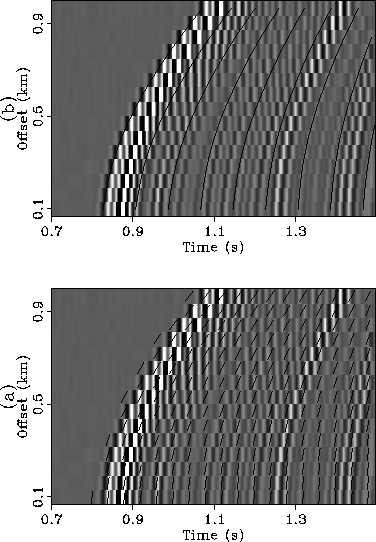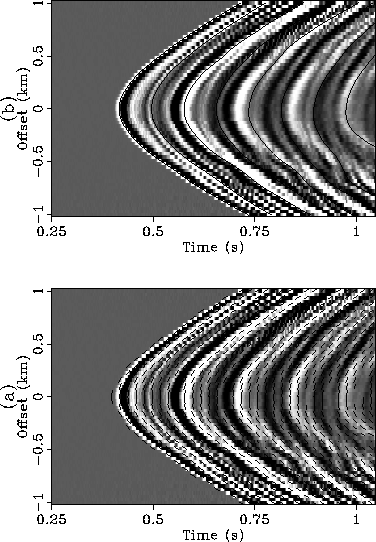To pick an event, I first manually identify the event at one location, and then let the event-picking program trace the event to both sides using the equation:
| (13) |
I applied my automatic picking algorithm to two field data gathers.
The first one is a common midpoint (CMP) gather on which the events
are seriously aliased at far offsets. The results of dip-picking
are shown in Figure ![[*]](http://sepwww.stanford.edu/latex2html/cross_ref_motif.gif) a.
The picked local dips are displayed by the small line segments whose
dips are equal to the dips of the events at those locations.
We see that the small line segments are always parallel to
the events shown on the background. The picked events are plotted
on top of the raster image of the CMP gather, as shown in
Figure
a.
The picked local dips are displayed by the small line segments whose
dips are equal to the dips of the events at those locations.
We see that the small line segments are always parallel to
the events shown on the background. The picked events are plotted
on top of the raster image of the CMP gather, as shown in
Figure ![[*]](http://sepwww.stanford.edu/latex2html/cross_ref_motif.gif) b. The picked curves follow the correct trajectories of
the events and ignore the coherent noises caused by aliasing.
b. The picked curves follow the correct trajectories of
the events and ignore the coherent noises caused by aliasing.
To understand why this picking algorithm has an anti-aliasing property,
let us look at an example of the objective function
computed in the step of the constrained non-linear optimization.
Figure ![[*]](http://sepwww.stanford.edu/latex2html/cross_ref_motif.gif) shows the objective function En(t,x,p) for a fixed x.
We see a sequence of minima that form a path from the left to the right.
We also see some local minima that do not form complete paths. These
local minima are created by the aliasing noise. If the unconstrained
optimization is used, the algorithm might mistakenly pick some of the local
minima. The constrained optimization forces the algorithm to pick
a complete shortest-path that is displayed by the solid curve in
Figure
shows the objective function En(t,x,p) for a fixed x.
We see a sequence of minima that form a path from the left to the right.
We also see some local minima that do not form complete paths. These
local minima are created by the aliasing noise. If the unconstrained
optimization is used, the algorithm might mistakenly pick some of the local
minima. The constrained optimization forces the algorithm to pick
a complete shortest-path that is displayed by the solid curve in
Figure ![[*]](http://sepwww.stanford.edu/latex2html/cross_ref_motif.gif) . For the same reason, the algorithm is not too insensitive
to noise in data.
. For the same reason, the algorithm is not too insensitive
to noise in data.
The second field data gather is a common-receiver gather
recorded in a walk-away marine survey. This gather is collected with many
shots on the surface and a receiver down in a well. The first arrival and
several events that follow it are down-going waves. After 0.75 seconds,
the up-going waves reflected from a deep layer start to interfere
with the down-going waves.
The picked local dips are represented by small line segments plotted in
Figure ![[*]](http://sepwww.stanford.edu/latex2html/cross_ref_motif.gif) a, and the picked events are displayed by the solid
curves shown in Figure
a, and the picked events are displayed by the solid
curves shown in Figure ![[*]](http://sepwww.stanford.edu/latex2html/cross_ref_motif.gif) .
Clearly, the algorithm performs reasonably well. It has no problem to
pick the dip at locations where a single event is present. At locations
where two or more events interfere with each other, the algorithm picks
the dip of the event that is relatively stronger and whose dip value does not
create an abrupt change of the dip function p(t).
Looking carefully at the picked curve for the first arrival, we see that a
``pull-down'' of the
first arrival at offset -0.6 km is correctly picked. This ``pull-down''
may be caused by a low velocity anomaly in the medium. This observation
suggests a good accuracy of the algorithm. This
event-picking method will probably be applied to traveltime inversion.
.
Clearly, the algorithm performs reasonably well. It has no problem to
pick the dip at locations where a single event is present. At locations
where two or more events interfere with each other, the algorithm picks
the dip of the event that is relatively stronger and whose dip value does not
create an abrupt change of the dip function p(t).
Looking carefully at the picked curve for the first arrival, we see that a
``pull-down'' of the
first arrival at offset -0.6 km is correctly picked. This ``pull-down''
may be caused by a low velocity anomaly in the medium. This observation
suggests a good accuracy of the algorithm. This
event-picking method will probably be applied to traveltime inversion.
 |
 |
 |